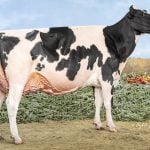Sustainability is a common theme in agriculture these days, and while grassland and forage are high on the list of sustainable land uses, they need proper management to stay healthy and provide the best value.
 Isabelle Thibout, Corteva Agriscience™
Isabelle Thibout, Corteva Agriscience™Isabelle Thibout, Product Manager for Horticulture, Pasture and Land Management at Corteva Agriscience, says producers have a variety of tools available to keep grass and pastures healthy. “We all know a healthy pasture leads to a healthy herd. The producer’s toolbox can include grazing rotation, fertility analysis and a health assessment of the pasture. Proper use of a Range & Pasture herbicide is another tool.”
Thibout says a regular pasture health assessment is critical in finding problems early, as invasive weeds can rob a pasture of up to 63 per cent of forage yield and profitable weight gain from the grazing cattle.
“Looking for the early signs of weeds and brush along the fence line or undisturbed areas, as well as small patches in the field, will give an early indication of trouble ahead. These invasive or even toxic plants will become harder to manage, the larger their populations become.”
Spring and fall scouting
The best time for weed assessment is when the plants are actively growing so you can see what’s there and how it’s evolving. Spring and fall scouting are a good idea because of the different growth periods for the various plants. Most western Canadian producers know the worst offenders. They include weeds such as tall buttercup, Canada thistle and common tansy, brush such as buckbrush and wolf willow, and sometimes trees such as aspen.
Livestock producers have resources to help them find problem plants and develop an integrated pasture management plan. “Local retail agronomists and the Corteva Agriscience team of Range & Pasture specialists will support producers to identify the main issues in their pastures and the best way to manage them,” says Thibout.
“One size doesn’t fit all when it comes to planning for pasture management. Depending on the pressure and the species, multiple tools and treatments may be required over the years.”
Even two fields side-by-side may require slightly different solutions. Weeds that are annual or perennial will also call for different approaches and plans.
Thibout says not treating invasive weeds has consequences for livestock health as well as pasture health.
“When the healthy grasses are less available to cattle, they will spend more time wandering and looking for feed and less time eating.” Some invasive plants may also be toxic to cattle leading to poor health or worse.
Thibout says that while they’re not drought-proof, healthy, managed pastures have a better chance to produce. “By removing competition for nutrients and water, you give pastures an advantage during the dry years.”
Tailored solutions
Corteva Agriscience offers some unique solutions for Range and Pasture management. Restore™ II herbicide fights broadleaf weeds. Reclaim™ II herbicide is focused on brush and includes control of broadleaf weeds. Grazon™ XC herbicide covers troublesome trees and broadleaf weeds. While these are tailored solutions for most pasture problems, more fine-tuning can be done with an agronomist if needed.
For example, while these treatments are safe for grasses when used according to the product label, they are not suitable for legumes like alfalfa. They will help to improve pasture grass stands by controlling invasive yield-robbers with residual activity however, they should not be sprayed if injury to existing forage legumes cannot be tolerated.
Being proactive is the key. Scout early and often. By managing invasive weeds and brush, producers can see more grass per acre and a healthier herd. It’s an investment in a sustainable grazing resource for the future.










